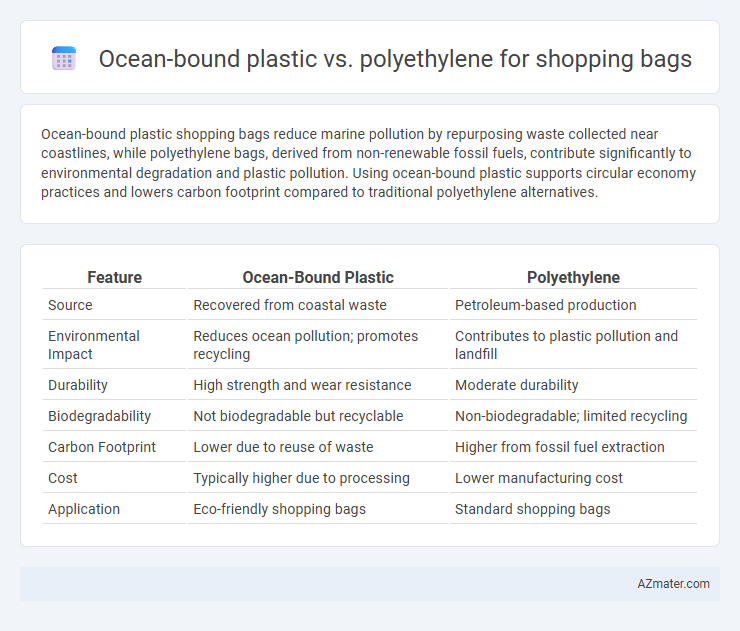Ocean-bound plastic shopping bags reduce marine pollution by repurposing waste collected near coastlines, while polyethylene bags, derived from non-renewable fossil fuels, contribute significantly to environmental degradation and plastic pollution. Using ocean-bound plastic supports circular economy practices and lowers carbon footprint compared to traditional polyethylene alternatives.
Table of Comparison
| Feature | Ocean-Bound Plastic | Polyethylene |
|---|---|---|
| Source | Recovered from coastal waste | Petroleum-based production |
| Environmental Impact | Reduces ocean pollution; promotes recycling | Contributes to plastic pollution and landfill |
| Durability | High strength and wear resistance | Moderate durability |
| Biodegradability | Not biodegradable but recyclable | Non-biodegradable; limited recycling |
| Carbon Footprint | Lower due to reuse of waste | Higher from fossil fuel extraction |
| Cost | Typically higher due to processing | Lower manufacturing cost |
| Application | Eco-friendly shopping bags | Standard shopping bags |
Introduction to Ocean-Bound Plastic and Polyethylene
Ocean-bound plastic refers to waste plastics collected within 50 kilometers of coastlines, preventing marine pollution and promoting environmental sustainability. Polyethylene, a widely used polymer in shopping bags, is valued for its durability, flexibility, and low production cost but contributes significantly to plastic pollution due to its resistance to degradation. Understanding the differences between ocean-bound plastic and polyethylene highlights the potential for incorporating recycled ocean-bound materials into manufacturing to reduce environmental impact.
What is Ocean-Bound Plastic?
Ocean-bound plastic refers to plastic waste collected within 50 kilometers of coastlines before it enters the ocean, targeting pollution sources to reduce marine debris. Unlike conventional polyethylene, which is typically derived from fossil fuels and non-recycled sources, ocean-bound plastic is recovered, cleaned, and recycled into sustainable materials for products like shopping bags. This process minimizes environmental impact by diverting potentially harmful plastics from ecosystems while promoting circular economy practices in the production of everyday items.
Understanding Polyethylene in Shopping Bags
Polyethylene, a widely used plastic in shopping bags, consists of long chains of ethylene molecules, offering durability and flexibility essential for carrying various items. Ocean-bound plastic refers to waste plastic collected near coastlines before entering marine environments, often recycled into polyethylene-based products to reduce ocean pollution. Understanding the composition and recyclability of polyethylene helps improve sustainable shopping bag alternatives by incorporating ocean-bound plastic materials.
Environmental Impact Comparison
Ocean-bound plastic derived from recovered waste significantly reduces marine pollution by repurposing debris before it reaches oceans, whereas traditional polyethylene shopping bags contribute extensively to plastic pollution due to low biodegradability and high production of fossil fuels. The carbon footprint of ocean-bound plastic bags is considerably lower, as they utilize existing materials and reduce reliance on virgin petrochemicals, leading to decreased greenhouse gas emissions. In terms of lifecycle, ocean-bound plastic bags support circular economy principles by diverting waste from landfills and waterways, contrasting with polyethylene bags which often end up as persistent environmental pollutants harming marine ecosystems.
Durability and Usability Differences
Ocean-bound plastic shopping bags offer moderate durability due to the recycling process, often resulting in slightly lower tensile strength compared to virgin polyethylene bags. Polyethylene bags exhibit superior flexibility, tear resistance, and moisture barrier properties, enhancing usability for carrying heavy or wet items. The environmental benefit of ocean-bound plastic is significant, but polyethylene remains preferred for long-lasting performance in everyday shopping scenarios.
Sourcing and Production Processes
Ocean-bound plastic used in shopping bags is sourced from coastal areas prone to plastic leakage into oceans, involving collection and rigorous cleaning processes before being processed into pellets for manufacturing. Polyethylene, typically derived from fossil fuels through polymerization of ethylene monomers, undergoes highly controlled industrial production with consistent quality and scalability. The sustainable advantage of ocean-bound plastic lies in diverting waste from marine environments, whereas polyethylene emphasizes cost-efficiency and material uniformity.
Cost Analysis: Ocean-Bound Plastic vs Polyethylene
Ocean-bound plastic shopping bags typically incur higher production costs due to the complex collection, cleaning, and processing required to convert waste into usable material, compared to polyethylene bags made from virgin or recycled resins. Polyethylene bags benefit from large-scale, established manufacturing processes that drive down raw material and production expenses, resulting in lower retail prices. Despite the upfront cost difference, ocean-bound plastic bags offer long-term environmental cost savings by reducing plastic pollution and contributing to circular economy initiatives.
Recyclability and End-of-Life Considerations
Ocean-bound plastic shopping bags often incorporate recycled materials derived from coastal waste, enhancing circular economy practices by diverting plastic from marine environments while maintaining recyclability through established plastic processing streams. Polyethylene bags, typically made from virgin or recycled polyethylene resins, are widely recyclable in municipal systems but face challenges due to contamination and low collection rates impacting effective recycling. Both materials require robust end-of-life strategies, with ocean-bound plastic bags emphasizing environmental impact reduction and polyethylene bags focusing on improving recycling infrastructure and alternative disposal options like chemical recycling or energy recovery.
Consumer Perception and Acceptance
Consumers increasingly perceive shopping bags made from ocean-bound plastic as eco-friendly alternatives to traditional polyethylene bags, associating them with sustainability and marine conservation. Despite polyethylene's widespread use and lower cost, many consumers prefer ocean-bound plastic bags due to their positive environmental impact and growing awareness of plastic pollution. Market acceptance for ocean-bound plastic bags is rising, driven by eco-conscious purchasing behaviors and government regulations promoting sustainable materials.
Future Trends in Sustainable Shopping Bags
Ocean-bound plastic shopping bags offer a sustainable alternative to traditional polyethylene bags by reducing marine pollution and utilizing recycled materials. Future trends in sustainable shopping bags emphasize increased use of ocean-bound plastics combined with biodegradable polymers to enhance environmental compatibility. Innovations in material science aim to improve durability and recyclability while minimizing carbon footprints in bag production.

Infographic: Ocean-bound plastic vs Polyethylene for Shopping bag
 azmater.com
azmater.com